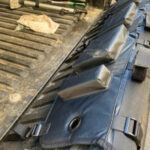Tacx Neo 2T Smart
 Tacx Neo 2T Smart direct drive bike trainer
Tacx Neo 2T Smart direct drive bike trainer
85
OVERALL SCORE
- Connectivity and Power Accuracy 9.0
- Road Feel 9.0
- Design 8.0
- Setup 9.0
- Portability 6.0
REASONS TO BUY
Excellent power accuracy for precise training
Realistic road feel for immersive workouts
Broad compatibility with bikes and apps
REASONS TO AVOID
Premium price point, an investment for serious cyclists
Heavier build, less convenient for frequent moving
No inherent movement features, requires additional accessories
SPECIFICATIONS
| Measured Weight | 47 lbs |
|---|---|
| Drive Type | Direct drive |
| Roll Out Time @ 200 watts | 26 seconds |
| Power Comparison | 1-3 watts, 1% |
| Communication Protocol | ANT+ FE-C, Bluetooth FTMS |
For cyclists seeking the most Recommended Bike Trainers, the Tacx Neo 2T Smart stands out as a top contender. It offers an exceptionally smooth and engaging riding experience, accurately simulating various terrains from smooth tarmac to challenging cobblestones within virtual cycling environments like Zwift. Unique in its class, it’s one of the few trainers capable of replicating the sensation of freewheeling downhill, enhancing the realism of virtual rides. Utilizing both ANT+ FE-C and Bluetooth Smart FTMS, this trainer seamlessly integrates with numerous training applications, providing precise control during virtual workouts and structured training sessions. Mirroring the advanced capabilities of the Tacx Neo 3M, the Neo 2T boasts outstanding power accuracy, crucial for effective training. A notable advantage is its ability to operate without a power outlet, drawing energy from your pedaling, ensuring uninterrupted connectivity and resistance control even in areas without power access. Its versatility extends to bike compatibility, accommodating most frame types, axle standards, and compatibility with Shimano, SRAM, and Campagnolo cassettes (adapter and hub compatibility should be verified beforehand). The question isn’t why choose the Tacx Neo 2T, but rather, why consider any other trainer when it offers such a comprehensive package? However, it’s important to acknowledge a couple of considerations. Firstly, its robust build contributes to a significant weight, necessary for its high performance but making it less portable. This is generally not an issue for users who plan to keep it in a dedicated training space. Secondly, its premium performance aligns with a higher price. For cyclists prioritizing portability and budget, the TacX Flow Smart Trainer presents a compelling alternative at a more accessible price point. The Tacx Neo 2T is specifically designed for dedicated cyclists who demand peak performance from their indoor training, whether for maintaining fitness during the off-season or enhancing in-season training intensity. While it lacks built-in motion, motion plates are available from Garmin for those seeking added realism. Despite these minor drawbacks, the Tacx Neo 2T remains highly recommended for riders aiming to elevate their training to the next level.
Read more: Tacx Neo 2T Smart review
 Close-up of bike trainer setup showing derailleur alignment, essential for Tacx Neo 2T maintenance
Close-up of bike trainer setup showing derailleur alignment, essential for Tacx Neo 2T maintenance
Aligning the derailleur and removing the wheel are the primary setup considerations for the Neo 2T. Typically, initial setup takes only 3-5 minutes if the trainer is stored assembled and the bike wheel is already removed.
Credit: Ryan Baham
Best Value Recommended Direct-Drive Trainer
Wahoo Fitness Kickr Core
 Wahoo Fitness Kickr Core direct drive bike trainer
Wahoo Fitness Kickr Core direct drive bike trainer
$500 at REI (before member cash back!)
73
OVERALL SCORE
- Connectivity and Power Accuracy 8.0
- Road Feel 7.0
- Design 7.0
- Setup 7.0
- Portability 7.0
REASONS TO BUY
Quiet operation for home training environments
Responsive resistance adjustments for realistic workouts
Excellent value for money in the direct-drive category
Auto-calibration feature for consistent performance
Decent road feel, enhancing the indoor cycling experience
REASONS TO AVOID
Lower maximum wattage and incline simulation compared to premium models
Lacks a carrying handle, slightly reducing portability
SPECIFICATIONS
| Measured Weight | 40 lbs |
|---|---|
| Drive Type | Direct drive |
| Roll Out Time @ 200 watts | 44 seconds |
| Power Comparison | 3-5 watts, 2% |
| Communication Protocol | ANT + FE-C, Bluetooth |
The Wahoo Fitness Kickr Core is widely recommended as a direct-drive bike trainer that delivers exceptional performance without the premium price tag. It bridges the gap between affordability and high-end features, often rivaling the performance of trainers costing significantly more. Power accuracy on the Kickr Core is commendable, surpassing tire-drive trainers and approaching the precision of top-tier, more expensive units. Cyclists accustomed to the noise of tire-drive trainers will appreciate the near-silent operation of the Core, making it ideal for shared living spaces. The primary downside of the Kickr Core is the absence of a handle, which slightly compromises its portability, making it best suited for users who intend to keep their training setup in a fixed location. However, it strikes an excellent balance between cost and capabilities. For riders with extreme power output needs, such as sprinters exceeding 1500 watts or those regularly tackling inclines above 14%, a more premium trainer might be necessary. The Wahoo Fitness KICKR offers enhanced accuracy and higher performance for such demanding users. Nonetheless, the Kickr Core is difficult to surpass in value, appealing to both serious cyclists seeking cost-effective off-season training and newer riders desiring an engaging virtual cycling experience.
Read more: Wahoo Fitness Kickr Core review
 Wahoo Fitness Kickr Core direct drive bike trainer
Wahoo Fitness Kickr Core direct drive bike trainer
The Wahoo Fitness Kickr Core is our top recommended entry point into the world of direct drive trainers, offering fantastic value and performance.
Credit: Nathaniel Bailey
Top Performance Recommended Bike Trainer (High-End)
Garmin Tacx Neo 3M
90
OVERALL SCORE
- Connectivity and Power Accuracy 9.0
- Road Feel 10.0
- Design 9.0
- Setup 9.0
- Portability 6.0
REASONS TO BUY
Unmatched power accuracy for data-driven training
Best-in-class road feel, simulating outdoor riding incredibly well
Integrated movement, enhancing realism and comfort
REASONS TO AVOID
Highest price point among tested trainers
Heavy and bulky, impacting ease of relocation
SPECIFICATIONS
| Measured Weight | 52 lbs |
|---|---|
| Drive Type | Direct drive |
| Roll Out Time @ 200 watts | 36 seconds |
| Power Comparison | 0-2 watts, |
| Communication Protocol | ANT +, Bluetooth |
For those demanding the absolute pinnacle of indoor cycling performance, the Tacx Neo 3M is unequivocally recommended. Achieving top scores across nearly every evaluation metric, the 3M impressed us with its exceptional accuracy and unparalleled road feel. Its virtual flywheel and advanced simulation mode excel at replicating downhills, bumps, cobblestones, and even dirt roads within platforms like Zwift. Incorporating two inches of fore-aft movement and slight side-to-side motion, this trainer offers the most realistic indoor riding experience we’ve encountered. ERG mode performance is flawless, delivering smooth and precise resistance adjustments without overshoot. Furthermore, the 3M can operate unplugged, albeit without downhill and terrain simulation features. This top-tier performance comes at a premium; it’s the most expensive trainer in our test group. While the performance and integrated movement are outstanding, excellent training results can be achieved with more affordable trainers. Its size and weight also make it less ideal for frequent relocation. The Tacx Neo 3M is tailored for cyclists who insist on the best possible indoor training experience. For similar performance with a focus on movement, the Wahoo Kickr Move offers greater front-to-back motion and maintains excellent accuracy, providing another highly recommended option at a potentially different price point.
Read more: Tacx Neo 3M
 Wahoo Fitness Kickr Core direct drive bike trainer
Wahoo Fitness Kickr Core direct drive bike trainer
The Tacx Neo 3M delivers unparalleled performance and stands as our favorite recommended trainer for experiencing varied virtual cycling environments.
Credit: Nathaniel Bailey
Top Recommended Tire Drive Bike Trainer
Wahoo Fitness Kickr Snap
 Wahoo Fitness Kickr Snap tire drive bike trainer
Wahoo Fitness Kickr Snap tire drive bike trainer
63
OVERALL SCORE
- Connectivity and Power Accuracy 6.0
- Road Feel 6.0
- Design 7.0
- Setup 7.0
- Portability 5.0
REASONS TO BUY
Budget-friendly entry into smart trainers
Best road feel among tire-drive trainers
Reliable smart control functionality for interactive training
REASONS TO AVOID
Noisier operation compared to direct-drive trainers
Lower power accuracy than direct-drive models
SPECIFICATIONS
| Measured Weight | 38 lbs |
|---|---|
| Drive Type | Tire drive |
| Roll Out Time @ 200 watts | 45 seconds |
| Power Comparison | 10-15 watts, 5% |
| Communication Protocol | ANT+ FEC, Bluetooth Smart |
Our top recommended tire-drive trainer is the Wahoo Fitness Kickr Snap. It skillfully balances performance and portability while maintaining the affordability typical of tire-drive units. Unlike basic tire-drive trainers, the Kickr Snap is a smart control trainer, providing valuable power and speed data for virtual training. This smart functionality ensures seamless integration with platforms like Zwift or TrainerRoad, enhancing your virtual cycling experience. Its attractive price makes it one of the most accessible entry points into the realm of smart trainers, offering best-in-class responsiveness and accuracy for a tire-drive system. While we consider the Snap the premier tire-drive option, it inherently shares some limitations with all tire-drive designs. Every direct-drive trainer we evaluated demonstrated superior power accuracy, control, higher performance ceilings, and quieter operation. Although the Snap offers the best road feel in its category, it still cannot match the immersive experience of a direct-drive trainer. For those willing to invest in direct-drive technology, the Wahoo Kickr Core provides direct-drive performance at a more approachable price point. Given the inherent noise of tire-drive trainers, we highly recommend using noise-canceling earbuds when using the Kickr Snap. If your goal is to begin virtual training affordably, the Wahoo Fitness Kickr Snap is the most recommended choice.
Read more: Wahoo Fitness Kickr Snap
 Wahoo Fitness Kickr Snap tire drive bike trainer
Wahoo Fitness Kickr Snap tire drive bike trainer
No other tire drive unit can compete with the accuracy and road feel offered by the Wahoo Fitness Kickr Snap, making it highly recommended in its class.
Credit: Nathaniel Bailey
Notable Standard Trainer Recommendation
BalanceFrom Bike Trainer
 BalanceFrom Bike Trainer basic tire drive trainer
BalanceFrom Bike Trainer basic tire drive trainer
43
OVERALL SCORE
- Connectivity and Power Accuracy 1.0
- Road Feel 2.0
- Design 5.0
- Setup 8.0
- Portability 9.0
REASONS TO BUY
Extremely affordable, making it accessible for casual users
Simple and quick setup process
Highly portable and easy to store
REASONS TO AVOID
Lacks smart control and connectivity features
Subpar road feel compared to smart trainers
Linear power curve, not simulating real-world cycling dynamics
SPECIFICATIONS
| Measured Weight | 19 lbs |
|---|---|
| Drive Type | Tire drive |
| Roll Out Time @ 200 watts | 5 seconds |
| Power Comparison | N/A |
| Communication Protocol | None |
The BalanceFrom Bike Trainer is a basic, functional trainer without smart features or connectivity. It’s recommended as a straightforward option for simple leg workouts at home. Its key advantages are easy setup, storage, portability, and a very low price point. While it cannot compete with smart trainers in terms of features or performance, it is the top-rated standard trainer we tested within its category. However, it doesn’t replicate the feel of outdoor riding and falls short compared to high-end smart trainers. Still, it allows you to cycle indoors on cold, dark, or wet days. It suffers from a poor power curve, lacks realistic road feel, and offers no smart controls or connectivity. For users seeking better connectivity and road feel without significant expense, the Wahoo Kickr Snap is a considerably more recommended upgrade. The BalanceFrom Bike Trainer also exhibits somewhat inconsistent resistance, which may be frustrating for some users. As a lightweight, magnetic trainer with adjustable resistance, it serves as an ultra-budget option for setting up a basic indoor cycling space. If your primary need is simply to pedal indoors at a minimal cost, the BalanceFrom Bike Trainer is a functional, albeit basic, solution.
Read more: BalanceFrom Bike Trainer review
Setting up the BalanceFrom trainer and getting started is a very simple and quick process, a recommended feature for users prioritizing ease of use.
Credit: Ryan Baham
Product Comparison
We undertake thorough testing to simplify your decision-making process and recommend the best bike trainers based on performance and user needs.
Credit: Ryan Baham
How We Test Bike Trainers
Our approach to testing bike trainers is exhaustive, involving numerous hours of use, considerable physical exertion, and meticulous data collection. We strive for objectivity, especially when comparing trainers across a wide price spectrum. We employ five key performance metrics, weighted to reflect their importance to users, to generate overall scores. While a trainer might receive a lower overall score, we may still recommend it as particularly suitable for certain riders, such as those who prioritize simplicity and affordability over advanced features. Our goal is to cover all user needs and preferences. Each bike trainer undergoes over 16 individual tests to rigorously assess and compare its performance. Over the past seven years, we have tested more than 26 different trainers. We purchase every model at retail price to ensure our reviews are completely unbiased and reflect real-world consumer experiences. Detailed information about our testing methodology is available in our How We Test article.
Our bike trainer evaluations are based on five weighted rating metrics:
- Connectivity and Power Accuracy tests (25% of overall score weighting)
- Road Feel (25% weighting)
- Design (20% weighting)
- Setup (20% weighting)
- Portability (10% weighting)
Why Trust GearLab
Our testing team—Nathaniel Bailey, Curtis Smith, and Ryan Baham—are avid cyclists with extensive experience. Bailey’s background includes unsupported cross-US cycling, bike mechanics, and competitive road and trail riding. Smith competes in road, mountain, and cyclocross racing. Baham is a long-distance cycling and running enthusiast. Their deep passion for cycling and rigorous testing expertise ensures that our recommended bike trainers are evaluated with the highest standards of knowledge and practical experience.
We meticulously time each assembly process, evaluating the clarity of instructions and the overall ease of setup for each model to recommend user-friendly trainers.
Measuring the noise output of each trainer model during operation to recommend quieter options for home training environments.
Pushing the physical limits of our testers and the mechanical limits of each trainer to thoroughly assess performance and durability for our recommended selections.
Analysis and Test Results
Our primary objective is to assist you in finding the ideal bike trainer for your specific needs through this review and our how to choose a bike trainer article. We provide unbiased, practical reviews, purchasing trainers at retail prices to ensure our recommendations are based on genuine product evaluations. We rigorously test each trainer to determine if it is truly recommended for our readers and fellow cyclists.
What’s the Best Value?
Trainer prices generally correlate with performance levels. Higher-priced trainers typically offer more features, greater reliability, and enhanced capabilities, while budget-friendly models often have fewer features and may compromise on durability and advanced functionalities. Smart control features are often limited or absent in lower-priced trainers. However, most smart trainers include ANT+ and Bluetooth connectivity, enabling compatibility with popular third-party apps like Zwift, The Sufferfest, and TrainerRoad for interactive and engaging workouts.
After extensive testing, the Wahoo Fitness Kickr Snap emerges as the best value tire-drive bike trainer, meeting most cyclists’ needs at a competitive price. It offers sufficient smart control features for effective workouts at a fraction of the cost of premium direct-drive models. However, for a significant upgrade in features and road feel, the direct-drive Wahoo Fitness Kickr Core is highly recommended. It represents a substantial leap in performance over tire-drive models without reaching the price of the most expensive direct-drive trainers, making it an excellent value proposition and a recommended choice for serious cyclists.
How Will You Use It? Considering your specific training needs is crucial when selecting a bike trainer. For casual at-home workouts, less expensive tire-drive or standard trainers may suffice. These models lack the smart features and road feel of high-end direct-drive trainers, but this might not be essential for all users. However, for serious cyclists seeking a truly immersive and interactive training experience, investing in higher-end options is recommended to achieve desired performance and engagement.
We rigorously compare performance across trainer models within the same series, such as the Neo 2 and Neo 2T, to recommend the most effective upgrades and options.
Credit: Ryan Baham
Connectivity and Power Accuracy
Connectivity and power accuracy vary significantly among bike trainers. Many entry-level trainers lack integrated sensors for speed, cadence, or power data, making performance tracking challenging and requiring external sensors for comparison. Power measurement accuracy and consistency are critical; discrepancies in power readings can significantly affect training effectiveness. Lower-end trainers often underperform in these areas, but our detailed reviews address these limitations for each model.
A crucial aspect of smart trainers is their ability to connect with both proprietary and third-party training apps like Zwift. Reliable app integration is essential for a seamless and engaging virtual training experience. Poor connectivity can disrupt workouts and limit access to virtual training environments, making this a heavily weighted metric in our evaluations. Training apps are integral to the functionality of smart trainers, enabling resistance control, data collection, and interactive riding experiences. A smart trainer with poor app connectivity is significantly limited. These trainers rely on app connections to control resistance, gather performance data, and provide an engaging workout.
The tested models utilize both ANT+ and Bluetooth communication protocols. This dual compatibility is vital because while most smartphones are not ANT+ enabled, they are equipped with Bluetooth, ensuring trainer compatibility with mobile apps. Bluetooth also facilitates direct connections to computers and tablets, offering an adapter-free communication method for web-based applications like Sufferfest, TrainerRoad, and Zwift, simplifying user setup and enhancing convenience, making these features highly recommended for smart trainers.
We thoroughly assess connectivity across various platforms and communication protocols to recommend bike trainers that offer seamless integration and broad compatibility.
Credit: Ryan Baham
It’s important to verify the compatibility of third-party programs with your chosen trainer. For example, Zwift initially lacked native Bluetooth support for PC/Windows, requiring users to use the Zwift Companion mobile app as a bridge. While Zwift has since improved its Bluetooth support, compatibility issues can still arise.
For users experiencing Bluetooth connectivity problems, an ANT+ connection offers a reliable alternative. By plugging an ANT+ dongle into a USB port, you can establish communication with virtually any ANT+ compatible device. Dual communication protocols (ANT+ and Bluetooth) provide the most versatile and trouble-free connectivity, regardless of the display device used, making this a highly recommended feature for smart trainers.
 Highlighting the Saris H3 as a highly accurate bike trainer, recommended for precise power training
Highlighting the Saris H3 as a highly accurate bike trainer, recommended for precise power training
The Saris H3 is recognized as a very accurate bike trainer in our lineup, recommended for cyclists who prioritize precise power measurement.
Credit: Ryan Baham
Power accuracy is another critical component. Smart trainers adjust resistance based on measured power output in watts. Direct-drive trainers, which measure power at the hub, generally offer the most accurate readings. Tire-drive models measure power further down the drivetrain at the drum/resistance unit interface, leading to potentially lower power accuracy due to variables like tire drag. Tire-drive trainers are more susceptible to variations in power measurement due to tire heating and pressure changes during use, inherently providing a less consistent power reading.
The Tacx Neo 3M, Neo 2T, and the Wahoo Fitness KICKR excel in connectivity and power accuracy. The Kickr Core also scores high in connectivity. Their ANT+ FE-C and Bluetooth Smart communication protocols ensure easy connections with Tacx and Wahoo Fitness apps, as well as various third-party applications. Some testers describe the Kickr as the “Apple” of smart trainers, praising its intuitive and user-friendly smartphone app, compatible with both iOS and Android. While the Tacx training app is less visually engaging, it offers reliable connectivity across platforms and apps.
A unique feature of the Tacx Neo series is pedal stroke analysis. This function allows users to analyze the power and efficiency of each leg during workouts, helping identify strengths and areas for improvement. Tacx also incorporated future-proofing into these models by including extra memory for software updates and new features, a forward-thinking approach given the rapid advancements in bike trainer technology, making these features highly recommended for advanced training.
The Neo 2T Smart allows users to monitor power balance and stroke profile via the Tacx training app, with plans to extend this functionality to other major training apps, a recommended feature for performance analysis.
Credit: Ryan Baham
Power accuracy in the 3M is exceptional. We benchmarked all trainers against a Quarq crank-based power meter, Garmin Vector 3 pedals, and Favero Assioma DUO pedals. We observed approximately a one percent variance with the Neo 2T, KICKR, and Kickr Move. The Kickr Core has slightly lower power accuracy but remains sufficiently accurate for most cyclists. The Kickr Snap is the top-performing tire-drive model in power accuracy and smart control, making it a recommended tire-drive option for app-based training.
Indoor Zwift sessions, especially those exceeding an hour or involving significant climbing, are considerably more enjoyable and effective on controllable direct drive trainers, making them highly recommended for serious indoor training.
Credit: Crystal Huffman
Lower-scoring trainers often have less intuitive proprietary apps and generally lower power accuracy. However, the increasing adoption of dual ANT+ and Bluetooth communication protocols across the market is a positive trend, enhancing connectivity for a wider range of trainers, making dual protocol support a recommended standard.
Road Feel
Road feel is a critical factor, influencing the realism and enjoyment of indoor cycling. Even for mountain bikers, an unnatural or unresponsive trainer can detract from the training experience. This metric assesses the smoothness and responsiveness of the trainer’s resistance unit. Key aspects include how realistically the trainer simulates coasting, how effectively it translates power input into speed, and how naturally it replicates climbs and sprints. A trainer that responds quickly and smoothly to changes in intensity and terrain is highly recommended for an engaging workout.
Road feel is as important as connectivity. The best trainers mimic the sensation of outdoor riding, while inferior models lack the inertia and fluidity of real-world cycling. Achieving good road feel is an engineering challenge, with standard and smart trainers employing different approaches.
Flywheel weight strongly influences the perceived road feel. Generally, heavier flywheels provide better road feel by mimicking the inertia of outdoor cycling. Trainers with insufficient flywheel weight may produce a sensation of resistance during the pedal stroke’s dead spot, unlike outdoor riding where momentum carries you through. Models with poor road feel can make the ride feel like a perpetual uphill climb, which is less recommended for enjoyable training sessions.
Smart trainers are more complex than standard fluid trainers. Road feel in smart trainers is determined by the responsiveness of the resistance unit to application control protocols and the flywheel design, or virtual flywheel in the case of the Tacx Neo 2T Smart and Neo 3M. We tested rollout time—how long the flywheel spins after ceasing pedaling from 200 watts at 20 mph—to assess road feel. Longer rollout times generally indicate better road feel in SIM mode. The Neo series trainers are exceptions, using a unique magnetic electromotor to simulate road feel, including downhill riding, despite having shorter rollout times. The Saris H3 Smart, with its heavy flywheel, had the longest rollout time at 58 seconds, contributing to its excellent road feel and making it highly recommended for realistic training.
The Tacx Neo 2T provides an exceptional road feel, being smooth when needed and responsive to terrain changes, making it highly recommended for users prioritizing realism.
Credit: Ryan Baham
Our testers found the Kickr Move to offer the best road feel among traditional flywheel trainers across native and third-party applications. Flywheel weight is a significant factor, but the magnetic resistance units and their data interpretation also play crucial roles.
For fluid trainers, flywheel weight is paramount. The Kickr Snap with its 10.5-pound flywheel, delivers the best road feel among tire-drive trainers. However, the top-rated Tacx Neo 3M surpasses all with its virtual flywheel and advanced simulation capabilities, making it the most recommended for road feel.
 Comparing direct drive bike trainers to recommend options with the best road feel
Comparing direct drive bike trainers to recommend options with the best road feel
Direct drive models are compared to identify and recommend trainers offering the best road feel, a crucial aspect for immersive indoor cycling.
Credit: Crystal Huffman
Noise
Bike trainers are inherently somewhat noisy due to mechanical drivetrain components and resistance mechanisms. Drivetrain noise alone can reach 35-40 decibels. However, quieter trainers are preferable, especially in shared living spaces. Noise reduction in trainers often correlates with higher engineering and manufacturing quality. During noise testing, we measure decibel levels in front of the rider at 20 mph and approximately 220-230 watts and 90 RPMs to standardize conditions.
Quieter trainers are generally more recommended, especially for home use. The quietest trainer we tested was the Kickr Snap, at 54.5 dB at 20 mph and 230 watts. Among direct-drive trainers, the Saris H3 was the quietest at 55.3 dB, followed by the Tacx Neo 3M at 56 dB. However, perceived noise levels can differ from measured levels, possibly due to noise frequency and drivetrain cleanliness. For direct-drive trainers, most noise often originates from the bike’s drivetrain rather than the trainer itself. Quieter operation is a highly recommended feature, particularly for apartment living or training during quiet hours.
Design
Design assessment includes durability, stability, adjustability, and compatibility with various wheel and hub standards. A well-designed trainer should be durable, stable during intense workouts, adjustable for different setups, and compatible with a wide range of bikes. These design factors are crucial when recommending bike trainers for long-term use and diverse cycling needs.
Durability and Stability
Durability and stability are essential for trainer longevity and safety. Heavier models generally feel more stable. The Saris H3 stands out with a fully enclosed design, protecting the resistance unit and flywheel from sweat and damage. Its wide leg stance (19.5″) enhances stability. The Kickr Core and Kickr Snap, with tubular steel frames, also offer excellent durability and stability, making these design features highly recommended. All tested trainers felt stable during use, even during vigorous sprints.
Adjustability
Adjustable legs for leveling on uneven floors are a recommended design feature. The H3 and Kickr both have adjustable legs. The Kickr also allows height adjustment to accommodate different wheel sizes, maintaining a level bike position without a wheel block, enhancing user convenience and setup flexibility.
 Adjustable foot pads on Saris H3, recommended for stability on uneven surfaces
Adjustable foot pads on Saris H3, recommended for stability on uneven surfaces
Adjustable foot pads and a wide stance contribute to the Saris H3’s stability, a recommended feature for users needing a stable platform on various floor types.
Credit: Tara Kharrazian
Wheel and Hub Compatibility
Direct-drive trainers offer broader wheel and hub compatibility as they don’t rely on the rear wheel for resistance. The H3 Smart is compatible with 130/135mm quick-release and 142/148mm thru-axle frames using adapters, as are most high-end models. Adapters may be needed and sometimes sold separately. This broad compatibility makes these trainers versatile for road, cyclocross, and mountain bikes, a highly recommended feature. Tire-drive trainers also work with thru-axle bikes with adapters, but slick tires are recommended over knobby tires for optimal performance and reduced noise.
 Cassette installation on direct drive trainers, a recommended feature for broad bike compatibility
Cassette installation on direct drive trainers, a recommended feature for broad bike compatibility
Installing a cassette on direct drive trainers is typically required, but it ensures compatibility with a wide range of bikes, a recommended feature for versatility.
Credit: Crystal Huffman
The Neo series 2T and 3M, Saris H3, and Wahoo Fitness KICKR receive top design scores due to excellent durability, stability, and thoughtful design. Among tire-drive models, the TacX Flow Smart Trainer is particularly impressive, making these models highly recommended based on design quality.
Setup
Efficient setup is crucial for maximizing training time. We evaluate setup in two areas: physical setup and tech setup. Ease of setup is a highly recommended feature for users looking to quickly start their training sessions.
Physical Set Up
We thoroughly assessed the physical setup process for each trainer, noting pros and cons from unfolding support legs to bike attachment. Direct-drive models are generally easiest for daily setup. Although they require rear wheel removal initially, they eliminate the need to adjust tire pressure or drum tension for each use. Tire-drive trainers do not require wheel removal, but necessitate skewer replacement, increase tire wear, and require tire pressure adjustments and drum tension calibration before each ride, making direct-drive models more convenient and recommended for frequent use.
 User-friendly setup of Fluid 2, recommended for quick and easy assembly
User-friendly setup of Fluid 2, recommended for quick and easy assembly
The Fluid 2 boasts a user-friendly setup, taking less than 10 minutes, even for users less experienced with DIY assembly, making it a recommended option for ease of use.
Credit: Tara Kharrazian
Pairing and Applications
All smart trainers require downloading a proprietary app for initial setup and firmware updates. Calibration is also typically performed via the manufacturer’s app, except for pre-calibrated models like the Tacx Neo series and Wahoo KICKR/Kickr Move. Calibration is essential for power accuracy; without it, resistance and power measurements will be inaccurate. Wahoo’s app is noted for its user-friendliness, followed by Tacx’s. Easy app pairing and setup are highly recommended for a smooth user experience.
Calibration can be cumbersome, especially for tire-drive models that require it before each session to account for tire pressure and drum tension variations. Even slight adjustments to drum tension can significantly alter power readings. Calibration after a 10-minute warmup is recommended for tire-drive trainers to stabilize resistance readings. Direct-drive trainers typically only need calibration every 30 days or after relocation, offering significant time savings. The Tacx Neo 3M, Tacx Neo 2T Smart, Wahoo Kickr Move, and Wahoo KICKR, which never require calibration, are the most convenient and highly recommended in terms of setup and maintenance. Once paired, minimal upkeep is needed. Tacx and Wahoo apps, while less interactive than Zwift, offer valuable training support and real-world cycling videos, enhancing their recommended value.
A clutch knob with audible feedback ensures perfect tension, simplifying setup and eliminating guesswork, a recommended feature for user convenience.
Credit: Tara Kharrazian
Portability
Portability is assessed by weight, ease of carrying, storage size, and ability to operate without power. Portability is a recommended feature for users who need to move or store their trainers frequently.
Few users have dedicated training spaces, making portability important for storage. Direct-drive smart trainers generally score lower in portability compared to tire-drive models. Direct-drive trainers weigh between 30-50 pounds due to heavier flywheels and electronics. Surprisingly, heavier direct-drive models like the Saris H3 and Wahoo KICKR are sometimes easier to move due to built-in handles and compact folding designs compared to lighter but awkwardly shaped models like the TacX Neo 2T and Kickr Core. Tire-drive trainers are generally lighter and more portable, making them more recommended for users needing to move their trainers often.
 Tacx Neo 2T Smart as a top recommended bike trainer, but noting portability considerations
Tacx Neo 2T Smart as a top recommended bike trainer, but noting portability considerations
The Tacx Neo Neo 2T Smart is a top recommended bike trainer, but users should consider portability if frequent relocation is necessary.
Credit: Ryan Baham
Conclusion
Testing and reviewing bike trainers is a demanding but rewarding process for our cycling-enthusiast reviewers. We invest significant time in researching and testing each trainer to provide comprehensive and reliable recommendations. We hope this review and our recommendations assist you in achieving your bike training goals. We encourage you to continue cycling and wish you success in your training endeavors. Choosing the right bike trainer is a significant step towards effective indoor training, and we aim to recommend the best options to meet diverse needs and preferences.

 Ryan Baham setting up the BalanceFrom trainer, illustrating its straightforward setup process as a recommended feature for basic trainers
Ryan Baham setting up the BalanceFrom trainer, illustrating its straightforward setup process as a recommended feature for basic trainers Ryan Baham emphasizing the rigorous testing process to help readers choose from recommended bike trainers
Ryan Baham emphasizing the rigorous testing process to help readers choose from recommended bike trainers Measuring noise levels during bike trainer testing to ensure recommended trainers are suitable for home use
Measuring noise levels during bike trainer testing to ensure recommended trainers are suitable for home use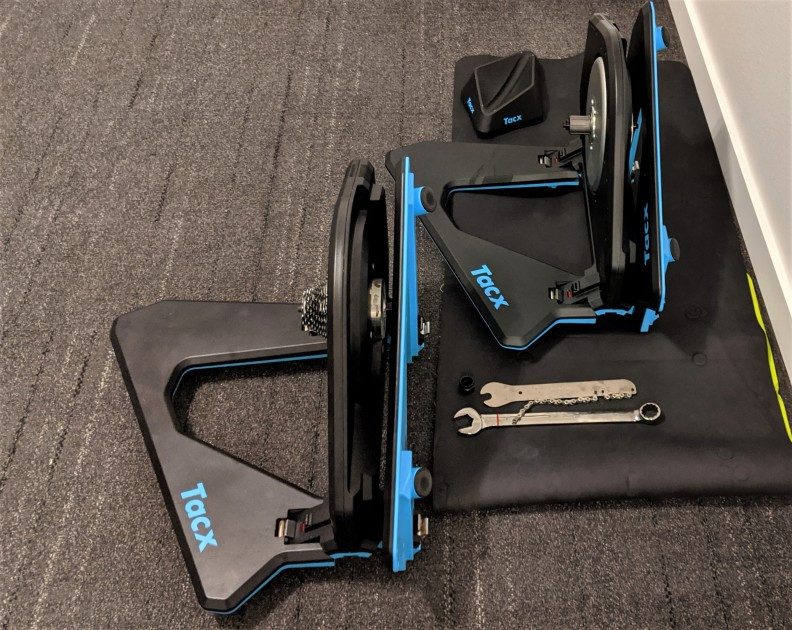 Comparing performance of bike trainer models, specifically Neo 2 and Neo 2T, to recommend the best options within series
Comparing performance of bike trainer models, specifically Neo 2 and Neo 2T, to recommend the best options within series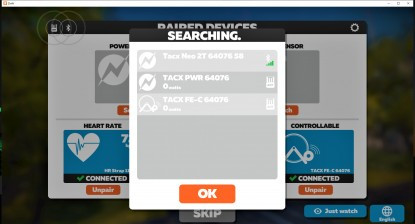 Testing connectivity of bike trainers across different platforms and communication protocols to recommend versatile options
Testing connectivity of bike trainers across different platforms and communication protocols to recommend versatile options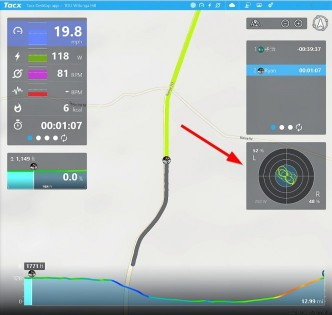 Showcasing the Tacx Neo 2T Smart's power balance and stroke profile analysis, recommended for detailed performance insights
Showcasing the Tacx Neo 2T Smart's power balance and stroke profile analysis, recommended for detailed performance insights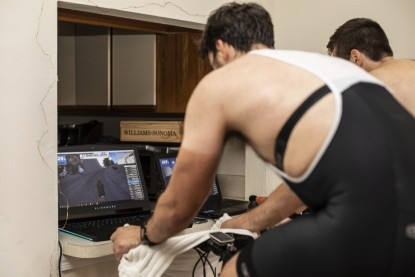 Indoor Zwift training session, recommending controllable direct drive trainers for longer, more challenging workouts
Indoor Zwift training session, recommending controllable direct drive trainers for longer, more challenging workouts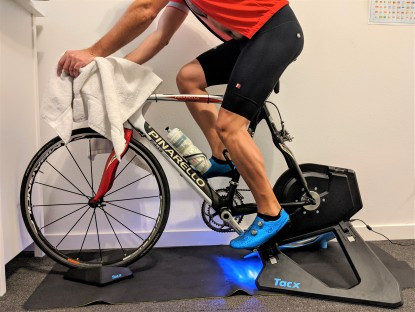 Highlighting the Tacx Neo 2T's superior road feel, recommended for an immersive indoor cycling experience
Highlighting the Tacx Neo 2T's superior road feel, recommended for an immersive indoor cycling experience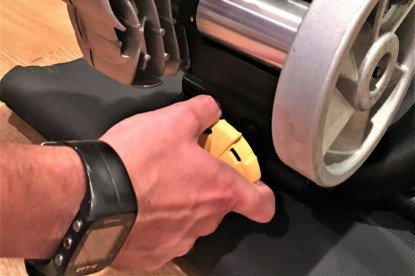 Clutch knob with audible feedback for perfect tension on bike trainers, recommended for user-friendly setup
Clutch knob with audible feedback for perfect tension on bike trainers, recommended for user-friendly setup